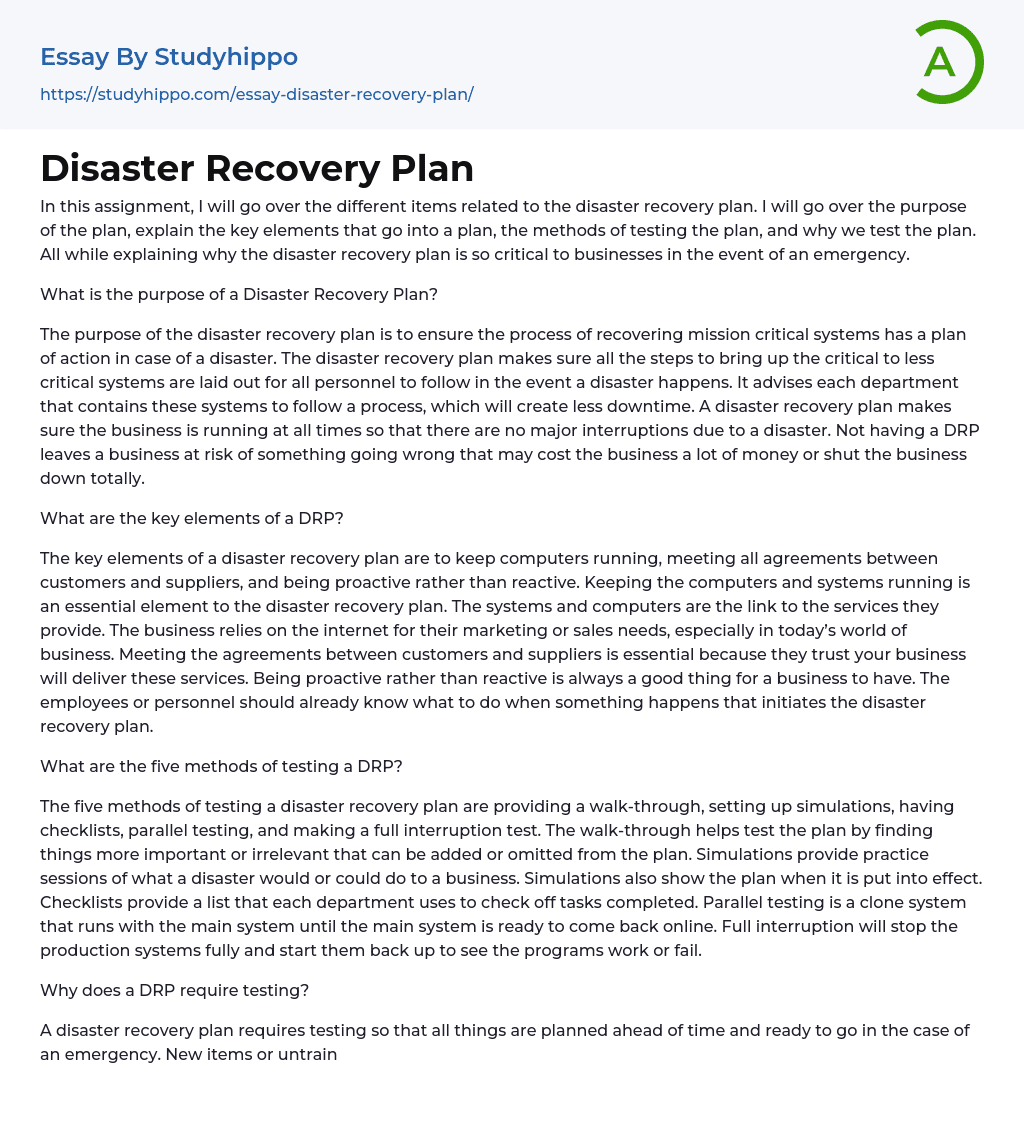The purpose of this assignment is to discuss different aspects of the disaster recovery plan, such as its importance for businesses during emergencies. It will cover key elements, methods of testing, and the significance of testing.
The purpose of a Disaster Recovery Plan is to determine the course of action to be taken in the event of a disaster or unexpected event that disrupts normal operations.
The main objective of the disaster recovery plan is to establish a clear action plan for recovering essential systems in case of a disaster. This plan ensures that all staff members are aware of the necessary steps to bring critical systems back online and minimize any downtime. All departments with these systems should follow the established process, which aims to reduce disruptions caused by a disaster. With a disaster recovery plan in p
...lace, the business can continue its operations without significant interruptions even during a crisis. On the other hand, not having a DRP puts the business at risk of potential losses or complete shutdown.
The crucial components of a Disaster Recovery Plan (DRP) include:
A disaster recovery plan requires several key components, including the continuous operation of computers and systems, fulfilling commitments to customers and suppliers, and taking a proactive approach. The functionality of computers and systems is critical for the successful execution of a disaster recovery plan because they are the tools that enable service provision. In today's business world, where internet reliance is high in marketing and sales activities, this importance becomes even more pronounced. Meeting obligations to customers and suppliers is crucial for maintaining their trust in th
business's ability to fulfill its promises. It is always advantageous for an organization to adopt a proactive mindset rather than reactively responding to events. Personnel should already be familiar with the necessary procedures when initiating the implementation of a disaster recovery plan.
The article discusses the five methods that can be used to test a DRP.
The five methods for testing a disaster recovery plan include a walk-through, simulations, checklists, parallel testing, and a full interruption test. During a walk-through, the plan is assessed to determine whether any important or irrelevant elements should be added or removed. Simulations allow for practice sessions to simulate the effects of a disaster on a business, as well as to demonstrate the effectiveness of the plan when implemented. Checklists serve as a task list for each department to mark off completed tasks. Parallel testing involves running a clone system alongside the main system until the main system is ready to be brought back online. Full interruption testing involves fully stopping production systems and restarting them to assess program functionality.
The necessity of testing for a DRP is questioned.
To ensure readiness for emergencies, a disaster recovery plan must be tested. This involves incorporating new elements and personnel into the plan and evaluating their effectiveness during emergencies. While a plan may seem effective in theory, its true functionality can only be assessed when put into action. The most reliable way to measure how objects and individuals react in such situations is by conducting a simulation of a disaster scenario.
The conclusion is written within a paragraph that has the HTML tag "p" and the attribute style="text-align: justify".
style="text-align: justify">
This assignment covers the essential components of a successful disaster recovery plan and explains the significance of having one for businesses. It is crucial to have a well-defined plan in place to ensure business continuity and avoid disruption in the event of a disaster.
- Auction essays
- Balanced Scorecard essays
- Business Plans essays
- Expense essays
- Income essays
- Net Income essays
- Security Guard essays
- Singapore Airlines essays
- Battle essays
- Intranet essays
- Maintenance essays
- Simulation essays
- Inn essays
- Chief Executive Officer essays
- Convenience Store essays
- Firm essays
- Training And Development essays
- Unilever essays
- Variable Cost essays
- Virgin Group essays
- Bargaining essays
- Entity essays
- Pest analysis essays
- Leadership and Management essays
- Change Management essays
- Project Management essays
- Knowledge Management essays
- Operations Management essays
- Quality Management essays
- Risk Management essays
- Scientific Management essays
- supply chain management essays
- Performance Management essays
- Time Management essays
- Brand Management essays
- Total Quality Management essays
- Risk essays
- Manager essays
- Leadership essays
- Business Ethics essays
- Board Of Directors essays
- Product Management essays
- Comparative Analysis essays
- Decision Making essays
- Dispute Resolution essays
- Stress Management essays
- Business Management essays
- Brand Equity essays
- Branding essays
- Nike, Inc. essays


Unfortunately copying the content is not possible
Tell us your email address and we’ll send this sample there.
By continuing, you agree to our Terms and Conditions.


